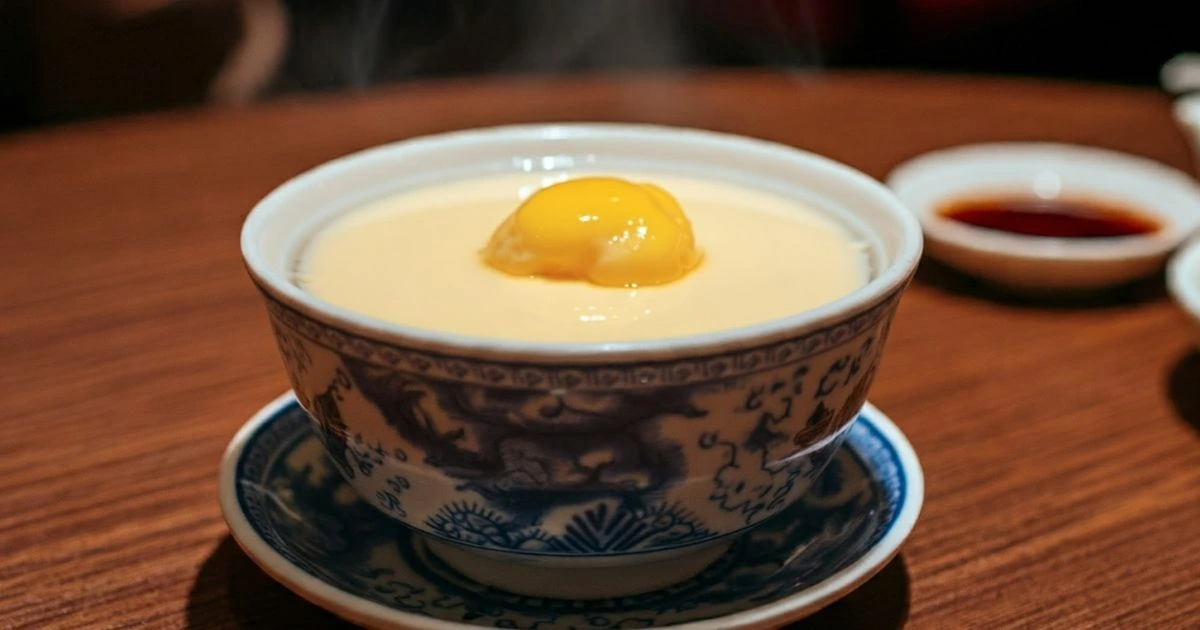Chinese Steamed Egg Custard: The Ultimate Guide to Silky Smooth Perfection
Discover the secret to creating restaurant-quality Chinese steamed custard and egg (蒸水蛋) that’s as smooth as silk and melts in your mouth. This savory custard, beloved across Asia, transforms simple ingredients into a cloud-like delicacy that will elevate any meal from ordinary to extraordinary.
Table of Contents
Why This Recipe Works
After consulting with Chinese chefs and testing multiple methods, we’ve perfected the water-to-egg ratio and steaming technique that ensures a perfectly smooth custard every time. Our method eliminates common problems like honeycomb holes and rough textures while delivering consistent results.
What Makes this custard and egg recipe Unique
- Perfect water-to-egg ratio
- Precise steaming temperature control
- Traditional flavor infusion method
- Double-straining technique
Recipe Card
| Recipe Details | Time/Quantity |
|---|---|
| Prep Time | 15 minutes |
| Cook Time | 10-12 minutes |
| Total Time | 27 minutes |
| Servings | 2-3 portions |
| Difficulty | Intermediate |
Ingredients
| Ingredient | Amount | Notes |
|---|---|---|
| Fresh eggs | 3 large | Room temperature |
| Warm water | 240ml | Filtered, about 180°F/82°C |
| Light soy sauce | 1 tsp | Premium quality |
| Sesame oil | ½ tsp | Pure sesame oil |
| Chicken stock or water | 60ml | For topping sauce |
| Green onions | 2 stalks | Finely chopped |
| White pepper | ⅛ tsp | Freshly ground |
| Salt | ¼ tsp | Fine sea salt |
Equipment Needed
- Steamer or wok with lid
- Heat-safe bowl (ceramic preferred)
- Fine-mesh strainer
- Cheesecloth
- Instant-read thermometer
- Aluminum foil
Step-by-Step Instructions
Preparing the Eggs
- Beat eggs gently in one direction (avoid bubbles)
- Mix warm water with salt
- Strain eggs through fine-mesh strainer
- Gradually stir in warm water mixture
- Strain entire mixture again
Setting Up the Steamer
- Bring water to boil in steamer
- Reduce to medium-low heat
- Cover bowl with foil
- Place in steamer
Steaming Process
- Steam on medium-low for 10-12 minutes
- Do not lift lid during cooking
- Check doneness with chopstick
- Let rest 2 minutes after cooking
Finishing Touches
- Heat light soy sauce and chicken stock
- Pour over custard
- Drizzle with sesame oil
- Garnish with green onions
Success Tips
Temperature Control
- Water should be warm but not hot
- Maintain gentle steam
- Never use high heat
- Keep lid closed
Texture Control
- Beat eggs in one direction
- Strain twice
- Remove all air bubbles
- Use warm water only
Expert Tips & Variations
What Sets This Recipe Apart
- Double Straining: Ensures ultimate smoothness
- Temperature Management: Specific heat control points
- Proper Water Ratio: Scientifically tested proportions
- Rest Period: Critical for texture development
Regional Variations
- Cantonese Style
- Add dried scallops
- Use superior stock
- Finish with ginger oil
- Shanghai Style
- Add dried shrimp
- Include Shaoxing wine
- Top with black vinegar
- Japanese Chawanmushi
- Add dashi stock
- Include mushrooms
- Add seafood garnish
Troubleshooting Guide
Common Problems & Solutions
Problem: Honeycomb Texture
- Solution: Lower heat
- Strain mixture thoroughly
- Remove air bubbles
- Use proper water temperature
Problem: Watery Surface
- Solution: Avoid steam drips
- Use aluminum foil cover
- Proper water-to-egg ratio
- Control steam intensity
Problem: Tough Texture
- Solution: Don’t overcook
- Check water temperature
- Maintain gentle steam
- Use room temperature eggs
Storage and Serving
- Best served immediately
- Can hold in steamer 5 minutes
- Don’t refrigerate
- Never reheat
Nutritional Information
(Per serving)
- Calories: 95
- Protein: 8g
- Fat: 6g
- Carbohydrates: 1g
- Sodium: 350mg
Serving Suggestions
- As part of Chinese meal
- With steamed rice
- As breakfast dish
- With congee
Frequently Asked Questions
Q: Why room temperature eggs?
A: They blend more smoothly and steam more evenly.
Q: Can I use a microwave?
A: Not recommended – steam provides best texture control.
Q: Why strain twice?
A: Ensures silky smooth texture without bubbles or imperfections.
Expert Resources
- Chinese Culinary Institute – Traditional Egg Dishes
- The Woks of Life – Chinese Cooking Techniques
- Asian Food Network – Steaming Methods
Mastering Chinese steamed egg custard takes practice, but with these precise techniques and tips, you’ll be creating restaurant-quality dishes at home. Remember that patience and attention to detail are key – the perfect steamed egg custard is worth the extra care!
Note: For best results, serve this dish immediately after cooking. The delicate texture is at its peak when fresh from the steamer.







